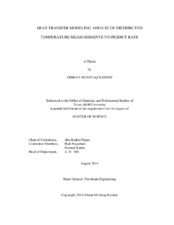| dc.description.abstract | Heat transfer modeling is important in many fields of engineering. In petroleum engineering, heat transfer modeling has many applications. One such application that this study focused on is flow rate estimation. In this work, two different models for estimating wellbore fluid temperature are highlighted with emphasis on using those models along with distributed temperature measurements to estimate rate of flow.
Both models employ mass, momentum and energy balance and are well established in the literature. The steady-state model is used where the fluid flow is essentially steady and any change in rate is followed by a sufficiently long steady schedule. The transient model is used where the well is still flowing in the initial stages or fluctuations in rate cause time of flow to be an important consideration. Flow rate estimation is predicated on the match between the measured and the estimated fluid temperatures.
Superposition of heat flow is developed in this work with regards to both steady-state and transient wellbore fluid temperature models. The superposition principle accounts for the changing heat transfer rate between wellbore fluid and formation which all flowing fluid temperature models in literature neglect.
Three case studies are presented to demonstrate the application of the methodology of rate estimation proposed. Fluid flow rates for steady and transient cases were successfully estimated within engineering accuracy for all three cases. In all three cases, in addition to the traditional downhole-pressure and surface-rate measurements, temperatures were recorded at various depths providing the data that allowed for testing of the models. The computational accuracy of flow rates increased at shallower depths owing to the increased heat transfer that was conducive to larger temperature differences, enhancing the fidelity of measurements.
The analysis also provides an opportunity to consider its use in other applications such as pre-cleanup transient testing. Computed rates from the proposed methodology can be used to perform transient analysis for the cleanup period. While the field examples strengthened the new rate-computation methods introduced here, simulated example shown at the end of the study probed the possibility of extracting meaningful information from the cleanup data. | en |


